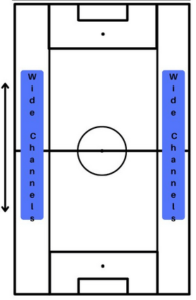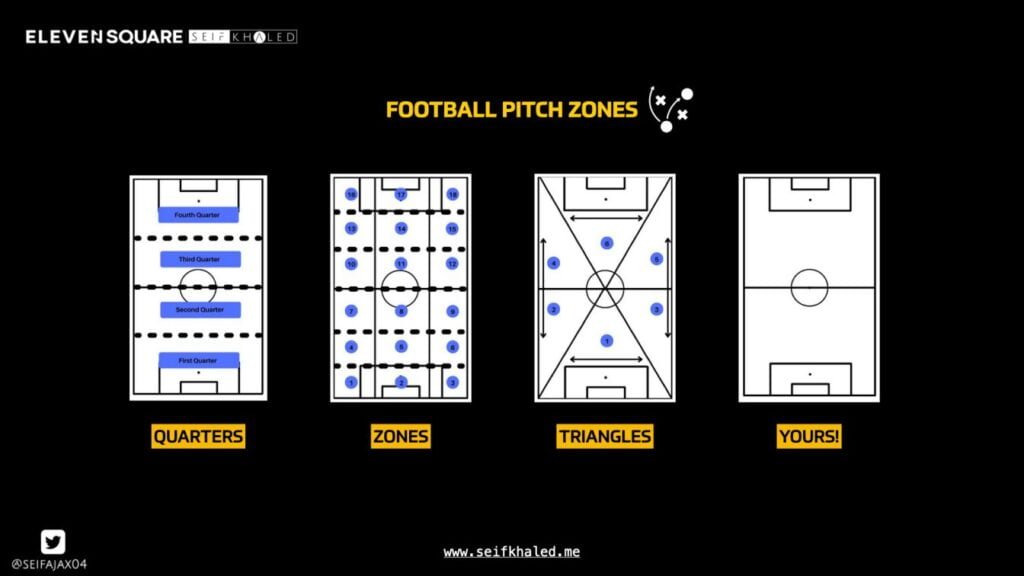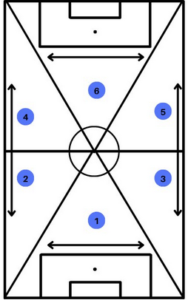Understanding the different zones on a football pitch is important for players, coaches, and referees to make informed decisions, develop effective strategies, and ensure fair play during a match.
Did you know that a football pitch is divided into several zones, including the penalty area, goal area, center circle, midfield line, touchlines, goal line, corner arc, and technical area?
Understanding these zones is crucial for players, coaches, and referees to make informed decisions and develop effective strategies during a match.

(1) HALVES:

In football, the pitch is divided into two halves, also known as “the halves”. The halves are separated by the midfield line, which runs horizontally across the pitch. Each half of the pitch is a mirror image of the other, with the same dimensions and markings.
During a match, each team defends one half of the pitch and attacks the other. The team that wins the coin toss at the beginning of the match gets to choose which half they want to start in. At halftime, the teams switch halves so that each team has the opportunity to attack and defend both halves of the pitch.
The halves are important because they can affect a team’s tactics and strategy. For example, a team may choose to play more defensively in their own half to prevent the opposition from scoring, or they may choose to play more aggressively in the opponent’s half to try and score a goal.
Overall, understanding the importance of the halves and the different zones on the pitch can help teams to develop effective tactics and strategies to win matches.
(2) Thirds:

The football pitch can also be divided into thirds for tactical purposes. These thirds are used to help teams organize their play and create more effective attacking and defensive strategies.
The pitch can be divided into two vertical thirds and three horizontal thirds. The vertical thirds run from the touchlines to the midfield line, while the horizontal thirds run from the goal line to the halfway line. The zones created by these divisions are known as the attacking third, the middle third, and the defensive third.
The attacking third is the area closest to the opponent’s goal, and it is where teams focus on creating scoring opportunities. The middle third is the area between the attacking and defensive thirds, and it is where teams work on maintaining possession and transitioning between attack and defense. The defensive third is the area closest to the team’s own goal, and it is where teams focus on defending and preventing the opponent from scoring.
Dividing the pitch into thirds can help teams to better understand their roles and responsibilities on the pitch, and to develop more effective strategies for attacking and defending.
(3) Wide Channels:

In football, the wide channels refer to the areas on the flanks of the pitch between the touchlines and the edge of the penalty area. These channels are often used by attacking teams to create width and stretch the opposition defense, allowing for more space to play and opportunities to cross the ball into the penalty area.
Wingers and full-backs are typically the players who operate in the wide channels, using their speed and skill to beat defenders and deliver crosses or cut inside to create scoring opportunities. Teams may also use overlapping runs, where a full-back runs past the winger to create an overload on the flank and draw defenders away from the center of the pitch.
Defensively, teams must be aware of the wide channels and work to prevent attacking players from getting into these areas. Full-backs and wide midfielders must track back to defend their flank and prevent crosses from coming into the box.
Overall, the wide channels are an important part of the pitch in football and can be used strategically by both attacking and defending teams to create or prevent scoring opportunities.
(4) Half Space:

In football, the half space is the area on the pitch between the sideline and the center of the pitch, approximately halfway between the touchline and the penalty area. It is also known as the “half channel” or “halfway zone”.
The half space is a key area of the pitch where attacking players can create chances and score goals. It is often used by attacking midfielders, wingers, and full-backs to make runs into the space, receive passes, and create scoring opportunities.
By receiving the ball in the half space, players can open up passing and shooting angles, as well as create overloads on the opposing defense. Attacking teams can also use the half space to create diagonal runs and passing options, which can stretch the opposing defense and create gaps for other players to exploit.
Defensively, teams must be aware of the half space and work to prevent attacking players from exploiting this area. This may involve marking players tightly in the half space, or using a zonal defense to cover the area and prevent passes from being played into the space.
Overall, the half space is an important area of the pitch in football, and teams that can effectively use or defend this area can gain an advantage in the match.

(5) QUARTERS:

Horizontal quarters are another way of dividing the football pitch into four sections, but instead of dividing it vertically, the pitch is split into horizontal sections.
To divide the pitch into horizontal quarters, a line is drawn across the pitch at the midpoint of the length, creating two equal halves. Then, a second line is drawn across the pitch at the midpoint of the width, creating four equal horizontal sections.
Each horizontal quarter can be used for different purposes, depending on the team’s tactics and strategy. For example, the back half of the pitch might be used for building up play from the defense, while the front half of the pitch might be used for creating scoring opportunities.
By using the horizontal quarters of the pitch, teams can create overloads in certain areas of the pitch and force the opposing team to adjust their defensive shape. For example, a team might focus their attacking play in the front two quarters of the pitch, using diagonal runs and quick passes to create space and scoring opportunities.
Defensively, teams must be aware of the horizontal quarters and work to prevent the opposing team from exploiting them. This may involve shifting their defensive shape to cover specific areas of the pitch, or using man-marking to track specific players who are operating in a particular quarter.
Overall, understanding the concept of horizontal quarters on the pitch can help teams to create more effective strategies and gain an advantage over their opponents.
(6) Zones:

Dividing a football pitch into 18 zones is not a standard practice, but it can be useful for coaches and analysts who want to get a more detailed understanding of the game. The exact method of dividing the pitch into 18 zones can vary, but one possible way to do it is as follows:
- Divide the pitch into three equal horizontal sections, creating three rows of equal length.
- Divide each of these three rows into six equal vertical sections, creating a total of 18 equal zones on the pitch.
- Label each zone with a number or letter to identify it. For example, the top left zone could be labeled “1A”, the center zone in the middle row could be labeled “2C”, and so on.
Coaches and analysts may use a system like this to analyze the game and identify patterns in play. For example, they may use the zones to track how often the ball is played in each area of the pitch, or to monitor the movement of individual players. However, it’s important to note that while dividing the pitch into more zones can provide a more detailed understanding of the game, it can also become more complex and difficult to interpret.
(7) Triangles:

Triangles are a common shape found in football (soccer) tactics and strategies. They are often used to create passing options, maintain possession, and create attacking or defensive patterns.
For example, in a 4-3-3 formation the attacking players may form a triangle with the center forward at the top and the left and right forwards on either side. This can create passing options for the midfielders and make it more difficult for defenders to mark all three attacking players.
Similarly, in a defensive system such as a 4-4-2, the midfielders may form a triangle to create a compact block and limit the passing options for the opposing team.
Triangles can also be used to create overlapping runs, where one player runs past another to receive a pass or create space. This can be seen in the way full-backs overlap with wingers in modern football.
Overall, triangles are a useful tool for understanding player movements and creating attacking or defensive patterns on the football pitch.
DON’T MISS OUT ON THIS OPPORTUNITY TO IMPROVE YOUR UNDERSTANDING OF THE GAME. DOWNLOAD NOW AND GET YOUR HANDS ON OUR PDF GUIDE TODAY!


Wow, superb blog format! How lengthy have you ever been blogging
for? you made blogging look easy.